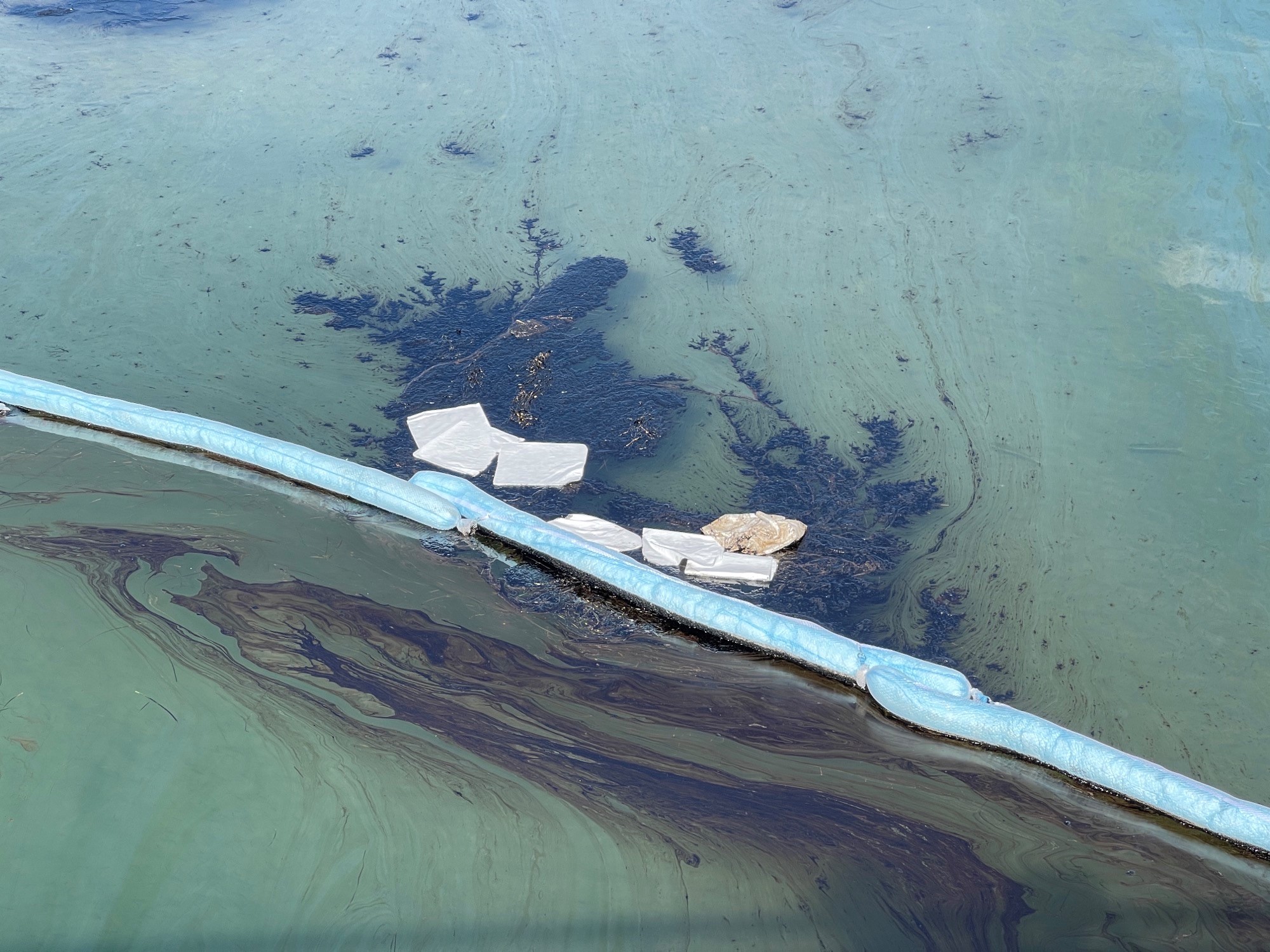Crews on the water and on shore worked feverishly Sunday to limit environmental damage from one of the largest oil spills in recent California history, due to a suspected leak in an underwater pipeline that fouled the sands of famed Huntington Beach and could keep the beaches there closed for weeks or longer.
As of early Monday morning, about 3,150 gallons of oil had been recovered from the water. More than 5,300 feet of booms were deployed on the ocean surface to try to contain the oil while divers sought to determine where and why the leak occurred.
What caused the leak has not been determined. Amplify Energy CEO Martyn Willsher, whose company operates the pipeline, was asked at a Monday news conference whether a ship's anchor striking the pipeline is to blame.
“We’re looking into if it could have been an anchor from a ship, but that’s in the assessment phase right now,” said Coast Guard Lieutenant Commander Jeannie Shaye.
Get top local stories in San Diego delivered to you every morning. >Sign up for NBC San Diego's News Headlines newsletter.
Coast Guard Capt. Rebecca Ore told reporters Monday afternoon that the
oil spill is not one large blot.
"I would characterize it as isolated ribbons of oil, or patches of oil,'' Ore said. ``It's constantly changing.''
Oil has been detected from Huntington Beach down to Dana Point and will continue flowing south with the current as it stands, with some already being seen in Laguna Beach, Ore said.
"It's not one large slick of oil covering this large area of miles,'' she said.
PHOTOS: Huntington Beach Oil Spill Causes Massive Ecologic Damage
On land, there was a race to find animals harmed by the oil and to keep the spill from harming any more sensitive marshland. At a news conference Monday morning, state wildlife officials said at least three oiled birds were collected. One of the birds, a brown pelican, was euthanized due to injuries.
More oiled bird sightings have been reported, officials said, adding that they are 'cautiously optimistic' that the number of birds in the area at the time of the spill might be lower than initially feared. They warned people who see oiled birds to report them to authorities and not to approach them.
Authorities did not have an estimate Monday morning on the number of animals who died in the spill. The recovery and cleanup process will likely continue for weeks, possibly months.
An estimated 126,000 gallons (572,807 liters) of heavy crude leaked into the waters off Orange County starting late Friday or early Saturday, when boaters began reporting a sheen in the water, officials said. The pipeline and operations at three off-shore platforms owned by Houston-based Amplify Energy Corp. were shut down Saturday night, CEO Martyn Willsher said.
He said the 17.5-mile (28.16-kilometer) pipeline that is 80 to 100 feet (24 to 30 meters) below the surface was suctioned out so no more oil would spill as the location of the leak was being investigated.
Huntington Beach Mayor Kim Carr said the beaches of the community nicknamed “Surf City” could remain closed for weeks or even months. The oil created a miles-wide sheen in the ocean and washed ashore in sticky, black globules.
“In a year that has been filled with incredibly challenging issues, this oil spill constitutes one of the most devastating situations that our community has dealt with in decades,” Carr said. “We are doing everything in our power to protect the health and safety of our residents, our visitors and our natural habitats.”
Crews led by the Coast Guard-deployed skimmers laid some 3,700 feet (1,128 meters) of floating barriers known as booms to try to stop more oil from seeping into areas including Talbert Marsh, a 25-acre (10-hectare) wetland officials said.
A petroleum stench permeated the air throughout the area.
“You get the taste in the mouth just from the vapors in the air,” Foley said.
The oil will likely continue to wash up on the shore for several days and affect Newport Beach and other nearby communities, officials said.
The closure included all of Huntington Beach, from the city's north edge about 6 miles (9.6 kilometers) south to the Santa Ana River jetty. The shutdown came amid summerlike weather that would have brought big crowds to the wide strand for volleyball, swimming and surfing. Yellow caution tape was strung between lifeguard towers to keep people away.
Officials canceled the final day of the annual Pacific Air Show that typically draws tens of thousands of spectators to the city of about 200,000 residents south of Los Angeles. The show featured flyovers by the U.S. Navy Blue Angels and the U.S. Air Force Thunderbirds.
The leaking pipeline connects to an oil production platform named Elly, which in turn is connected by a walkway to a drilling platform named Ellen. Those two platforms and another nearby platform are in federal waters.
Elly began operating in 1980 in an area called the Beta Field. Oil pulled from beneath the ocean and processed by Elly is taken by the pipeline to Long Beach.
Huntington Beach resident David Rapchun said he's worried about the impact of the spill on the beaches where he grew up as well as the local economy.
“For the amount of oil these things produce I don’t think it’s worth the risk,” Rapchun said. He questioned whether drilling for oil was a wise idea along some of Southern California’s most scenic beaches, noting the loss of the final day of the air show could deal a blow to the local economy.
“We need oil, but there’s always a question: Do we need it there?” he said.
The spill comes three decades after a massive oil leak hit the same stretch of Orange County coast. On Feb. 7, 1990, the oil tanker American Trader ran over its anchor off Huntington Beach, spilling nearly 417,000 gallons (1.6 million liters) of crude. Fish and about 3,400 birds were killed.
In 2015, a ruptured pipeline north of Santa Barbara sent 143,000 gallons (541,313 liters) of crude oil gushing onto Refugio State Beach.
The area affected by the latest spill is home to threatened and endangered species, including a plump shorebird called the snowy plover, the California least tern and humpback whales.
“The coastal areas off of Southern California are just really rich for wildlife, a key biodiversity hot spot,” said Miyoko Sakashita, director of the Center for Biological Diversity’s oceans program.
The effects of an oil spill are wide-ranging, environmentalists said. Birds that get oil on their feathers can’t fly, can’t clean themselves and can’t monitor their own temperatures, Sakashita said. Whales, dolphins and other sea creatures can have trouble breathing or die after swimming through oil or breathing in toxic fumes, she said.
“The oil spill just shows how dirty and dangerous oil drilling is and oil that gets into the water. It’s impossible to clean it up so it ends up washing up on our beaches and people come into contact with it and wildlife comes in contact with it,” she said. “It has long-lasting effects on the breeding and reproduction of animals. It’s really sad to see this broad swatch oiled.”
Has a spill like this happened before off Orange County?
An estimated 3,400 birds were killed when the American Trader oil tanker ran over its anchor and punctured its hull on Feb. 7, 1990, spilling an estimated 416,600 gallons of crude oil off the coast of Huntington Beach. As a result of the spill, the Wetlands and Wildlife Care Center was established March 31, 1998, at 21900 Pacific Coast Highway to help injured and orphaned wildlife including oil-soiled birds, according to the DFW. A makeshift facility at that site treated birds injured in the 1990 spill, according to the center's website.
NBCLA's Jonathan Lloyd contributed to this report.



